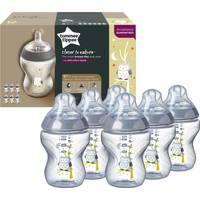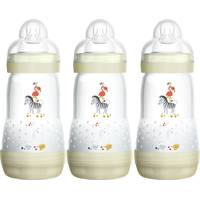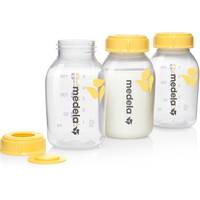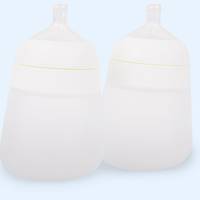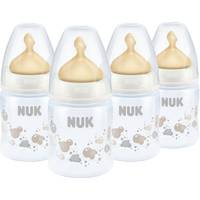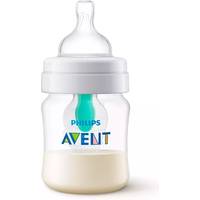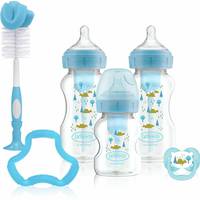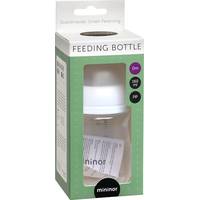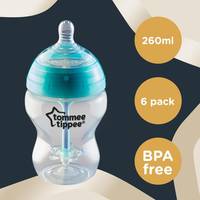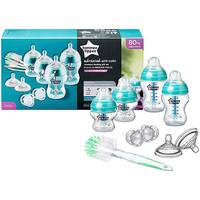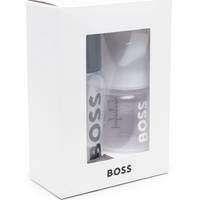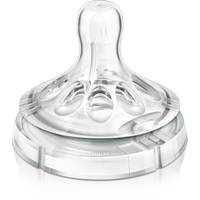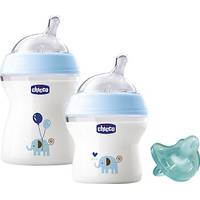MAM Easy Start Anti-Colic Bottle 320ml Blue 4M+
Description
Reduces air bubbles and colic2Teat with symmetrical, flat and soft shape.Its shape imitates the mother's nipple for a familiar breastfeeding experience.Ideal in combination with breastfeeding Large openings for easy filling and cleaningWith the exclusive self-sterilization function: ideal for use outside the homeDesigns printed on both sides: clear design and stylish themes for little trendsetters ACTION AND DESCRIPTION A bottle with a nipple appropriate to the age, size, physiological characteristics and preferences of the baby must be chosen, since the degree of acceptance of the bottle, the quality of suction and the correct development of the jaw and palate will depend on this. - It must be ensured that the flow of water, milk or food is adequate. In no case is it advisable to increase the size of the orifice, since this suppresses the feeling of tiredness (necessary for the satiety of the infant) and favors the development of poor digestion, with vomiting and abdominal pain. - Special care must be taken with the state of conservation and hygiene, sterilizing them periodically and renewing them when necessary. - The bottle must be prepared by adjusting the proportions of milk and water to the doses prescribed by the pediatrician or as specified by the manufacturer. Overly concentrated bottles can cause symptoms of dehydration and digestion problems, while overly diluted ones do not feed adequately. - When the child does not completely use up the contents of the bottle, the excess should be thrown away. Milk should also not be reheated or left at room temperature for more than a few minutes. - After each feeding, you must wash the bottle immediately since milk is an excellent culture medium for bacteria. LATEX ALLERGY Does not contain latex. CONSERVATION AND EXPIRATION The term "cleaning" children's dishes does not imply the same meaning for all people, therefore, it is advisable to make a series of recommendations in order to achieve the same routine for all people who care for the infant. The cleaning process must constitute a habit, a daily routine that must always be carried out in the same way, so that regardless of the person in charge of cleaning, the result is optimal and guarantees the asepsis of the material. Cleaning children's dishes is essential, because the infant's body has a weak antigenic capacity, so an infection, such as gastroenteritis, can have very serious consequences. All material that will be in contact with the newborn must have optimal hygienic conditions. - Before preparing the bottle, wash your hands well with soap and dry them with a clean towel. - Any microorganism must be eliminated by boiling or using the usual sterilizers. While the baby is fed by its mother, hygiene monitoring is reduced to the few items that the baby can put in the mouth, which are the fingers and the pacifier, but the transition to artificial breastfeeding, especially if it is earlier at 4 months, implies not only that the contribution of the immune defenses contained in the mother's milk is lost, but, and above all, that a risk factor is incorporated, because a remnant of warm milk becomes a bacterial culture medium. The routine should begin when a feeding ends: "After each feeding, the bottle must be washed with plenty of hot water, soap and a brush." - A series of used and washed items can be accumulated (the number depends on the type of technique chosen), for sterilization, generally once a day, and left to dry. - There are different types of sterilizers on the market, based on various physical or chemical procedures, to eradicate the microbial load. In the case of thermo-resistant materials, there are tablets or solutions that act when cold. There is the option of sterilizers that use the germicidal effect of boiling water vapor or that originating from electrical appliances of various kinds. a) Cold sterilization Chemical process that uses the oxidizing action of hypochlorous acid, in the form of a solution or tablets It allows items to be sterilized just by placing them (bottles, teats, nipples, pacifiers, teethers or toys) in a bucket with water and a chemical solution (in the form of a solution or tablets). Sterilization time varies, ranging from half an hour to an hour. The solution must be renewed every 24 hours to avoid possible infections. Sterilized items must be rinsed. b) Heat sterilization Boiling water destroys pathogenic microorganisms. Sterilization occurs through water vapor and lasts 10 to 20 minutes. The bottle is previously filled with water up to two thirds of its volume.Shop Online Mam Easy Start Anti-Colic Bottle 320ml Blue 4M+ at best price. Product features: - Baby Accessories: Baby Bottles
You may also like
loading
Discover more








































